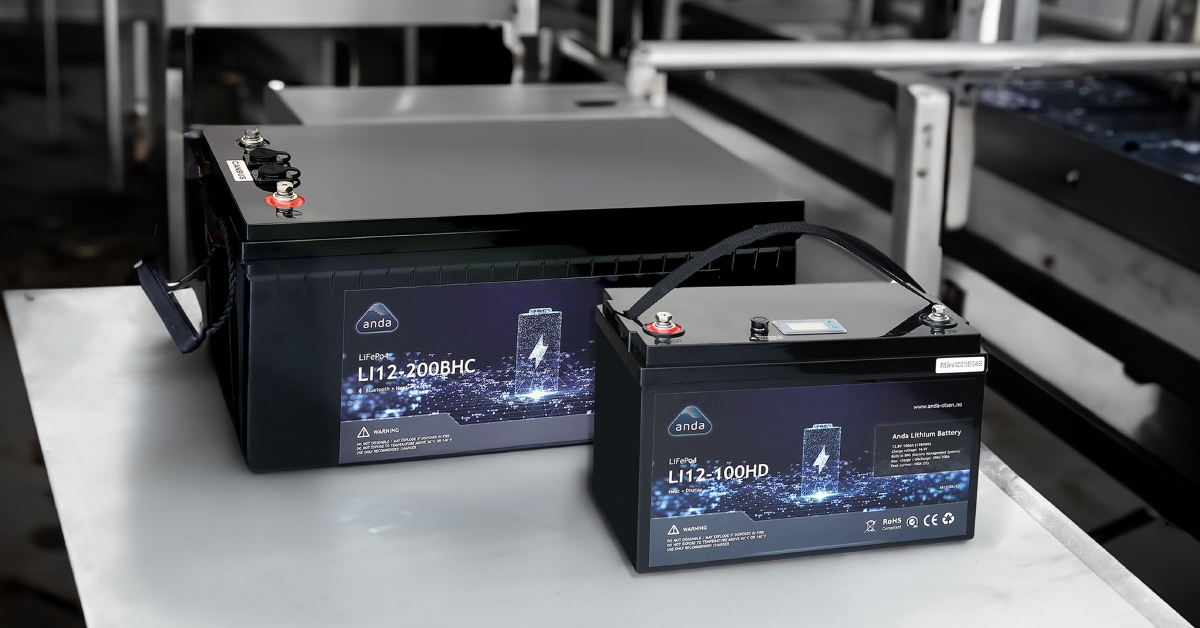Du er her: Forside -> English - > Pros and Cons of Lithium Batteries

Pros and Cons of Lithium Batteries
Publisert 06.02.2024
In an era where lithium batteries are becoming increasingly central, it is essential to understand the challenges associated with this technology.
This article will provide insights into the critical aspects of lithium batteries, potential pitfalls, and risks of use. However, there is no cause for concern, as Anda-Olsen emerges as a reliable supplier, well-prepared to efficiently tackle these challenges.
Challenges with Lithium
1. Overheating During Charging
One of the most significant concerns with lithium batteries is the risk of overheating during the charging process. This issue poses not only a threat to the battery itself but also to surrounding components and safety in general. Therefore, it is crucial that the battery has a good BMS (Battery Management System) to prevent this.
2. Dynamo
Charging lithium batteries with a dynamo can introduce some challenges. High charging current, automatic disconnection, and voltage spikes can occur, which may lead to damage to the equipment.
3. Temperature Sensitivity
Lithium batteries are sensitive to temperature, and this affects their performance. Without proper regulation, they can lose efficiency and reliability, especially under extreme temperature conditions. The lack of heating elements in the batteries can lead to reduced lifespan and performance, and this is a significant challenge that must be addressed for reliable use of lithium.
4. Cost and Alternatives
It is always important to consider the costs and carefully evaluate all options before acquiring batteries. Despite their popularity, lithium batteries are not always the most economical choice. In certain applications, lead-acid batteries have proven to be a significantly more cost-effective alternative. Therefore, the economic aspect should be carefully weighed against specific needs and lifespan requirements.
5. Recycling and Environment
Although they typically have a longer lifespan, the recycling of lithium presents a significant challenge that requires careful consideration in terms of the environment. Users are encouraged to weigh the long-term benefits against the challenges that recycling presents. The challenges associated with recycling include the complexity of the batteries, lack of standardization, risk of fire and explosion, limited infrastructure, economic barriers, and lack of incentives.
Research is focused on developing safer and more cost-effective recycling technologies, while legislation and incentives are becoming increasingly important to promote sustainable practices within recycling.
6. Market and Quality
The lithium market is relatively young and characterized by chaotic conditions with many players entering the arena. The lack of structure and competition from various suppliers increases the risk of low quality and potential defects in products. Buyers face challenges in distinguishing between reliable and less reliable options. This complicates the decision-making process and introduces risks related to quality and reliability.
7. Transport Risk
Due to their classification as hazardous materials, lithium batteries face challenges in transportation, especially in comparison to VRLA lead-acid batteries. This includes restrictions on air freight, which adds complexity to logistics and compliance with regulations.

Anda-Olsen's Responsible Solutions
Overheating and Voltage Concerns
Anda-Olsen acknowledges the risk of overheating during the charging of lithium batteries and offers a solution in the form of the Orion XS 12/12-50A (700W) DC-DC charger from Victron Energy. This device ensures regulated charging, prevents overheating and equipment damage, thereby enhancing the safety of the entire system.
Temperature Control for Optimal Performance
By recommending batteries with heating foil, Anda-Olsen ensures users can maintain optimal efficiency even under varying temperature conditions. This proactive approach to temperature control improves the reliability of lithium batteries. All Anda Lithium batteries (except rack models) are equipped with heating foil.
The heating foil surrounds the battery cells and uses some of the energy supplied to the battery for the heating foil, ensuring that the cells reach a certain temperature so they can be charged even if the room temperature is below freezing. The heating foil does not draw power until the battery is about to charge.
Read more: Anda-Olsen delivers crucial battery backup for avalanche safety
Cost-Effectiveness
Understanding that cost is a crucial factor, Anda-Olsen guides users towards making informed decisions. In cases where lithium batteries may not necessarily be the most cost-effective option, lead-acid batteries are introduced as a viable and economical alternative. The goal is to balance costs and performance to achieve optimal efficiency and sustainability in various applications.
Quality and Environmental Responsibility
Anda-Olsen acts as a safeguard against many uncertainties in a chaotic market. By exclusively using components from reputable suppliers, such as EVE, and maintaining strict quality control, the company ensures that its products not only meet but also exceed several industry standards.
Safety in Transportation
Understanding the challenges associated with the transportation of lithium batteries, Anda-Olsen offers solutions that comply with safety regulations. The commitment to responsible transportation aligns with industry standards and ensures the safe delivery of lithium batteries.
Anda-Olsen's Commitment to Safety and Quality
Anda-Olsen's commitment to delivering the highest possible quality products and accessories emphasizes its role as a reliable partner in the pursuit of safe and efficient solutions in a large and sometimes complex market.
Here you can read more about Anda-Olsens self developed lithium batteries.